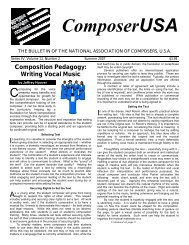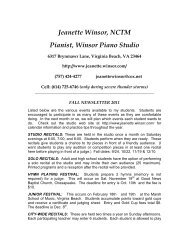1999-2007 - Music-USA.org
1999-2007 - Music-USA.org
1999-2007 - Music-USA.org
You also want an ePaper? Increase the reach of your titles
YUMPU automatically turns print PDFs into web optimized ePapers that Google loves.
MARK ALBURGER is an eclectic American composer of postminimal, postpopular, and postcomedic sensibilities. He is<br />
Editor-Publisher of IOrh-Centuty <strong>Music</strong> Journal, an award-winning ASCAP composer of concert music published by New <strong>Music</strong>,<br />
oboist, pianist, vocalist, recordmg artist, musicologist, author, and music critic. Dr. Alburger began playing the oboe and<br />
composing with Dorothy and James Freeman, Ge<strong>org</strong>e Crumb, and Richard Wernick. He studied with Karl Kohn at Pomona<br />
College; Joan Panetti and Gerald Levinson at Swarthmore College (B.A.); Jules Langert at Dominican College (M.A.); Roland<br />
Jackson at Claremont Graduate School (Ph.D.), and Terry Riley. Dr. Alburger's recent performances have included the Chicago<br />
premiere of Orpheus Cycle and the premiere of a new chamber orchestra version of the same work with the Sounds New<br />
ensemble. His Business as Usual will be performed yet again by Tuolumne Brass in June. Two CDs are currently in production:<br />
Business As Usual [New <strong>Music</strong>]- with Molly Axtmann, Elizabeth Lee, and Jeana Ogren - and The Twelve Fingers [North/South<br />
Consonance] with Max Lifchitz. He recently completed Animal Fann: Grand Zoological Fanmsy-Variations and is cwently at<br />
work on his Symphony No. 4 ("Sequence <strong>Music</strong>'j).<br />
SYMPHONY NO. 1 IN C MAJOR, OP. 21 ("It wasnt classical, it was symphonic ..." "It wasn't a symphony, because it<br />
did not have a sonata allegro...") (1998) is the first of a projected series of nine "grid" symphonies based on<br />
correspoilding numbered works by older composers. The magic book for this composition is that of Beethoven's<br />
Symphony No. 1, from which is taken form and spirit (including exact number of measures, tempo markings, key, and<br />
even opus number), but little content The lengthy subtitle refers to overheard comments which form the melodic bases<br />
of two themes in the opening movement. The third-movement Menuetto e Trio, actually a scheno in the Beethoven<br />
model, is a manic and melancholy gallop through sardonic classical and minimalist material. The music was written in<br />
two days of February 1998: the first sunny (a bright Menuetto), the second cloudy (a dark Trio). Philip Glass and<br />
Beethoven's Fur Elise commiserate in the latter section's sour snap rhythms.<br />
JOANNE D. CAREY holds a Bachelor's Degree and Mastds Degree in <strong>Music</strong> Composition from San Jose State University,<br />
where she studied with Allen Strange and Lou Harrison. A guest composer at the Center for Computer Research in <strong>Music</strong> and<br />
Acoustics (CCRMA, Stanford University) since 1983, she lives in Palo Alto with her husband and two children. In addition to<br />
composing, she has collaborated H;ith composer-inventor Max Mathews on the development of new improvisation programs for<br />
his radio-baton. Ms. Carey has composed three computer-generated tape pieces at CCRMA. Two of these, Zntonatim of the<br />
Wind (1990) and Clouds'Lament (1988) are based on FM synthesis of singing tones and represent an intense exploration of this<br />
medium. Her recent work has focused on pieces using the Radio-Baton with a live soloist These include a song cycle, Three<br />
Spanish Songs and Adventures on a Theme for Flute and Radio-Baton, which uses improvisation programs she developed with<br />
the help of Max Mathews. The Three Spanish Songs have been performed in Guanajuato, Mexico (1 9%), in San Jose, California<br />
(1995), at the 1995 SEAMUS (Society of Electro Acoustic <strong>Music</strong> in the United States) conference in Ithaca, New York and in<br />
Warsaw and Krakow (1993).<br />
AQUI (1993) along with its companions La soledad (1992) and Gmcias (1994), were inspired and influenced by<br />
Spanish Flamenco and indigenous South American music, and the later poetry of Chilean poet Pablo Neruda. The<br />
spirituality and humanity of this great poet continues to impress me deeply. In the process of blending Neruda's poetry<br />
with the rhythms, flourishes and instrumental sound of these Spanish and South American musical traditions, I drew<br />
mainly from strains of solitary meditation and deep sorrow buoyed by irrepressible exuberance and hope. The score of<br />
the electronic accompaniment was created on a Macintosh IIfx using a composition program called DMM that was<br />
developed by Stanford graduate Daniel Oppenheim, DMA. The sound material was generated on a Yamaha SY77.<br />
Most of the voices are presets, with the exception of the bell sounds and a couple of hybrid sounds that I constructed<br />
and a sound that might be described as a "sliding sigh" that was made by Dr. Oppenheim.<br />
NANCY BLOOMER DEUSSEN is well known throughout the San Francisco Bay Area as a composer, performer, arts <strong>org</strong>anizer<br />
and music educator. She is a leader in the growing movement for more melodic, tonally oriented contemporary music and is co-<br />
founder of the SF Bay Chapter of the National Association of Composers, <strong>USA</strong>. Her works have been performed throughout the<br />
US and Canada and she has received numerous commissions both locally and nationally from such performers and ensembles as<br />
The Oakland Chamber Orchestra, The Walnut Street Chamber Ensemble, The Baton Rouge Concert Band, The Bresquan Trio,<br />
The Santa Clara Chorale, The Women's Caucus in the Arts, OPUS 90 Chamber Ensemble, Richard Nunemaker, clarinetist, the<br />
Tanana High School Band, the Gabrieli Brass, Soundmoves, the Mission Chamber Orchestra, the Semper Virm environmental<br />
group, and The Sandusky <strong>Music</strong> Festival. The 98-99 season will bring a performance of her orchestral work Ascent to Victory by<br />
The California State Hayward Symphony Orchestra, this work just having been released on a BMS CD. Performances of her<br />
Pegasus Suite will take place in the Bay Area, England, Sweden, Mexico and Greece; a performance of Parisian Caper will take<br />
place at The National Saxophone Convention in Atlanta, GA.<br />
PARISIAN CAPER was a commissioned work for SOUNDMOVES, an ensemble from Western Oregon University. It<br />
was premiered in January 1998 at the university with the composer in residence. It was one of the featured works at<br />
this y&s National Saxophone Conference held in Atlanta, GA. It depicts a whirlwind tour of Paris with the espresso<br />
houses, jazz clubs and walks along the Seine.




